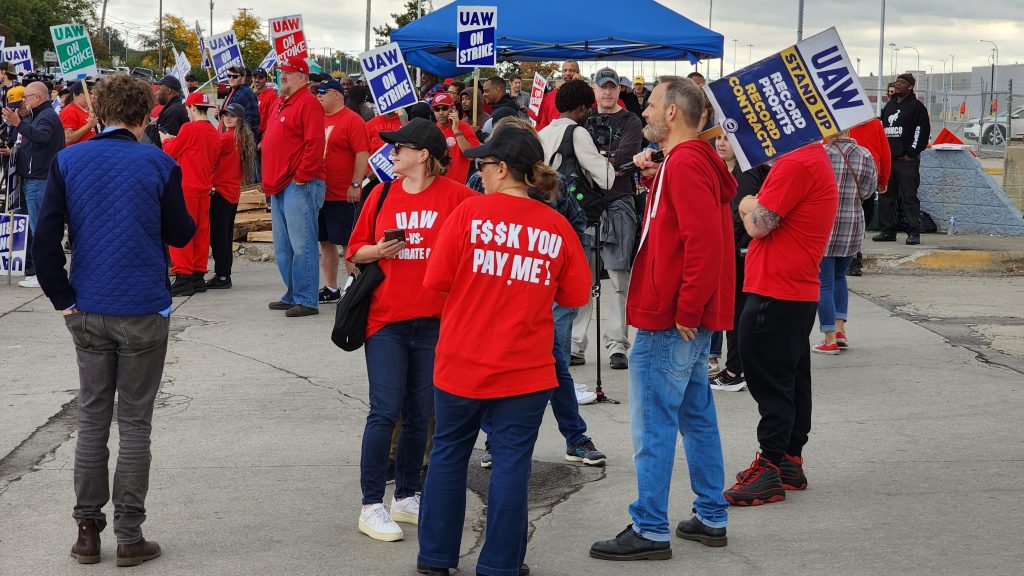Union members, automakers losing money as UAW strikes continue
Analysts say striking facilities are costing car companies millions, while picketing workers receive less than a normal week’s income.

UAW members strike outside of Ford's Michigan Assembly Plant in Wayne, Mich.
It’s been three weeks since the United Auto Workers union’s contracts with Ford, Stellantis and General Motors expired. The last time the union and Detroit’s automakers were in need of a new deal in 2019, it took six weeks to get the first contract done.
But the union is exercising different bargaining tactics this time around. It’s picketing all three manufacturers at once and increasing the number of walkouts as talks continue.
That’s a departure from the so-called “pattern bargaining” method the UAW has used on Detroit’s Big Three in the past — when strikes and negotiations were targeted at one automaker at a time.
With no precedent for the new strategy, it’s anyone’s guess how long it will take to resolve the strikes.
Listen: The financial repercussions of bargaining for automakers and union members
The impact on automotive companies
In the past, striking an automaker often meant bringing instant, widespread walkouts across its entire network. While the UAW’s new negotiating tactic means strikes grow incrementally as the weeks go by, car companies are still losing money.
President and CEO at the Center for Automotive Research, Alan Amici, says stoppages are costing manufacturers millions of dollars per day. He says the longer members picket outside of plants, the more difficult it will be to make up for lost revenue.
“These plants are scheduled for five or six days a week,” says Amici, “with preventative maintenance on the weekends. When you go down with production there are not enough days left in the year to make-up those lost units.”
“Some of these (suppliers) can’t weather an extended drop in demand.” — Alan Amici, Center for Automotive Research
One thing Detroit’s car companies got good at while navigating supply chain issues during the COVID-19 pandemic is just-in-time manufacturing. It involves streamlining part deliveries so that production can quickly adapt to meet demand, rather than building in advance of need.
Stellantis, Ford and GM executives have all said those lessons have stayed with their companies post-COVID and made them more profitable. However, those who didn’t build a surplus of items in advance of the strikes could feel the impact on their bottom lines sooner.
Beyond the Big Three, Amici says the walkouts are also being felt by automotive suppliers.
“Some of these tier two and tier three suppliers are rather small companies as well,” Amici said. “If there is no demand for their product…some of these (suppliers) can’t weather an extended drop in demand.”
The impact of represented workers
Represented members on picket lines are not receiving their full salaries. Instead, the UAW is paying them $500 dollars per week in strike pay.
As walkouts and resulting layoffs in the supply chain continue, Amici says the reduced income for many workers can have an impact beyond the auto industry.

“You’re tightening your belts, you’re not going out to dinner as much,” he said, “you’re kind of curbing your spending. And so there can be kind of a chilling effect on the rest of the local economies.”
As the third week of strikes comes to an end, there are picket lines outside of 15 union automotive facilities in Michigan. Two of those are assembly plants and 13 are part distributors.
That means more represented members are currently earning strike pay in Michigan than anywhere else in the U.S. At the time of this post, no other state has more than two facilities on strike.
Trusted, accurate, up-to-date.
WDET strives to make our journalism accessible to everyone. As a public media institution, we maintain our journalistic integrity through independent support from readers like you. If you value WDET as your source of news, music and conversation, please make a gift today.
